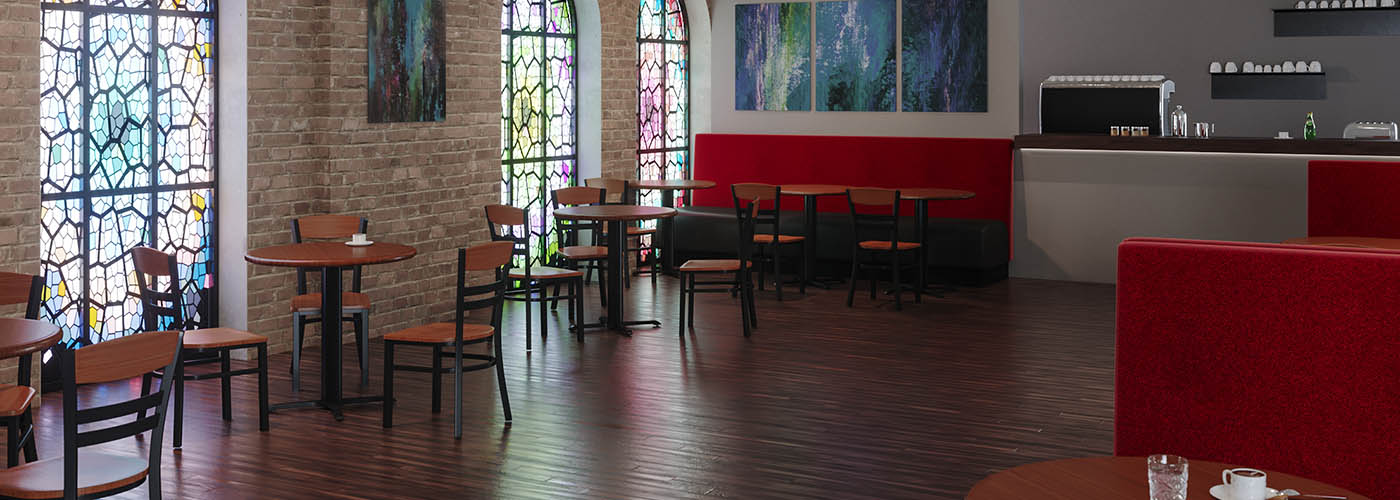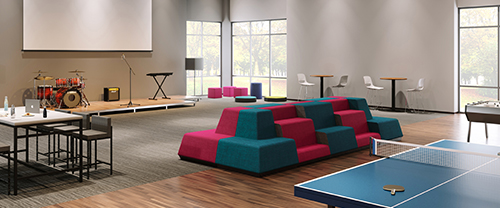
Designing Churches for Generation Y and Z
While First Baptist Jonesboro in Jonesboro, GA, offers contemporary services, the church recently addressed a significant issue: its worship style may be modern, but the building’s interiors looked like … well, those of a traditional church that didn’t resemble the spaces that appeal to members of Generations Y and Z. In an effort to continue growing by attracting younger members, First Baptist Jonesboro reached out to CDH Partners, based in Marietta, Ga., to conduct a re-design of the spaces surrounding the church’s sanctuary.“[Churches] all seem to be asking the same thing: what do we do to get the new kids in here? Our answer is: in some way, make it feel like the social settings that they’re used to without offending the older generations that [also] come to church,” says Paulla Shetterly, principal at CDH. For Jonesboro First Baptist, the firm applied a rustic modern feel that blends wood and metal, with high-top tables and lounge chairs that are reminiscent of what we would find in a coffee house. The design incorporates charging stations so that occupants may recharge their devices on site, so that those who wish to post their activities to social networks don’t have to worrywhen their batteries are low.

Providing gathering space in proximity of the main worship center enables people to come to church in a way that is most comfortable to them, Shetterly points out. While many worshippers continue to participate in serves in the actual sanctuary, others––especially those new to church––may prefer to listen and observe in a less formal setting. “Everybody wants to hear the service whether they’re in the sanctuary or not, but a lot of people feel like they don’t necessarily want to go to church because they’re afraid they might be judged, or it’s just not their thing,” she says. “If you put them in an environment outside of the sanctuary where you still hear the pastor speaking, and the music, then they feel more comfortable immediately.”
But it’s not just newcomers who desire a more informal approach to church. Shetterly observes that, in contemporary houses of worship at least, how people follow services in general has shifted. “It’s no longer: sit in church and be a good listener,” she says, “and I think the opportunity to have these spaces outside of these sanctuaries are giving us a good canvas [upon which] to create different environments.”
At the same time, design that addresses younger church members is only part of the equation, Shetterly cautions. “If we create the coolest environments ever and the pastor is not changing how they preach––at least in contemporary worship––then it’s not that much help,” she says. “The built environment and the process of ministry have to come together as one.”
Sharon Exley: Thoughts on Designing for Gen Y and Z
Get Technical
Sharon Exley, MAAE, ASID, and co-founder of Architecture is Fun Inc., an architecture and design firm based in Chicago, Ill., reminds us that technology and connectivity are a given for young adults––something that designers need to consider. They are also very concerned with how we’re treating our planet, she adds. “They pretty much live digitally, consume with more spontaneity, and have a sensitivity to sustainability,” she notes. Environments that address this are hip, but not contrived; they convey authenticity, and often incorporate sustainable products.
Get Social
Members of both Generations Y and Z are incredibly social, and spaces designed to attract them should reflect this. “Provide space that allows them to work on-the-run, to co-create, to lounge, to check in or out, and to get involved,” Exley says. Her firm has designed a number of “caves”––enclosed, modular (and therefore modifiable) spaces situated within a larger area––that can be used for collaborative work, or simply hanging out. “We’ve been creating caves where technology allows the space to be totally transformative––technology is the message, device and connector. The pop-up, ephemeral attitude helps spaces look new and feature unexpected moments [because these generations] judge visually whether or not you can hold their attention.”
Get Adaptable
The team at Architecture is Fun also designs reconfigurable furnishings, such as the Pyramid Bench, an interlocking seating area that, as Exley describes, “blurs the boundaries between public space and exhibit, furniture and interactive object, and play and learning.” She says that this year the firm is adapting the design for young adults with the goal of promoting both socialization and engagement: “This version gears up to permit gaming, charges digital tools, instigates selfie moments, and connects users with face-to-face fun.” Because the Pyramid Bench is modular, users can change their environment to suit their needs on the fly. Recesses in the bench are designed to house a number of digital tools, such as VR masks.
Get Arty
Exley also suggests that spaces displaying artwork and art installations that are changed on a regular basis is attractive to these generations. (“Think of the walls as more of a gallery rather than as a one-time, rubber-stamped expression,” she advises.) Her firm has been working with young artists at Ava Grey, a Chicago-based creative agency, on a project involving the creation of an eco-garden built from broken or discarded skateboards, but the possibilities are endless. “What if drones could buzz with digital messaging? What if sculpture glowed with energy saved from daylight? What if the drapes were made from solar cells? What if a cave projected ways to get involved with outreach, virtually planting you in places where you could make a difference?” she challenges. The goal, she says, is to tell stories through design that both Gen Y and Z will want to tell others about. “Share the stories of re-use, eco art, interaction and limited edition product with Gen Y and Z––they’ll find value in it. Creating Instagrammable spaces can be an innovative way to nurture involvement––online and in person.”
ARTICLE BY CHURCH.DESIGN
